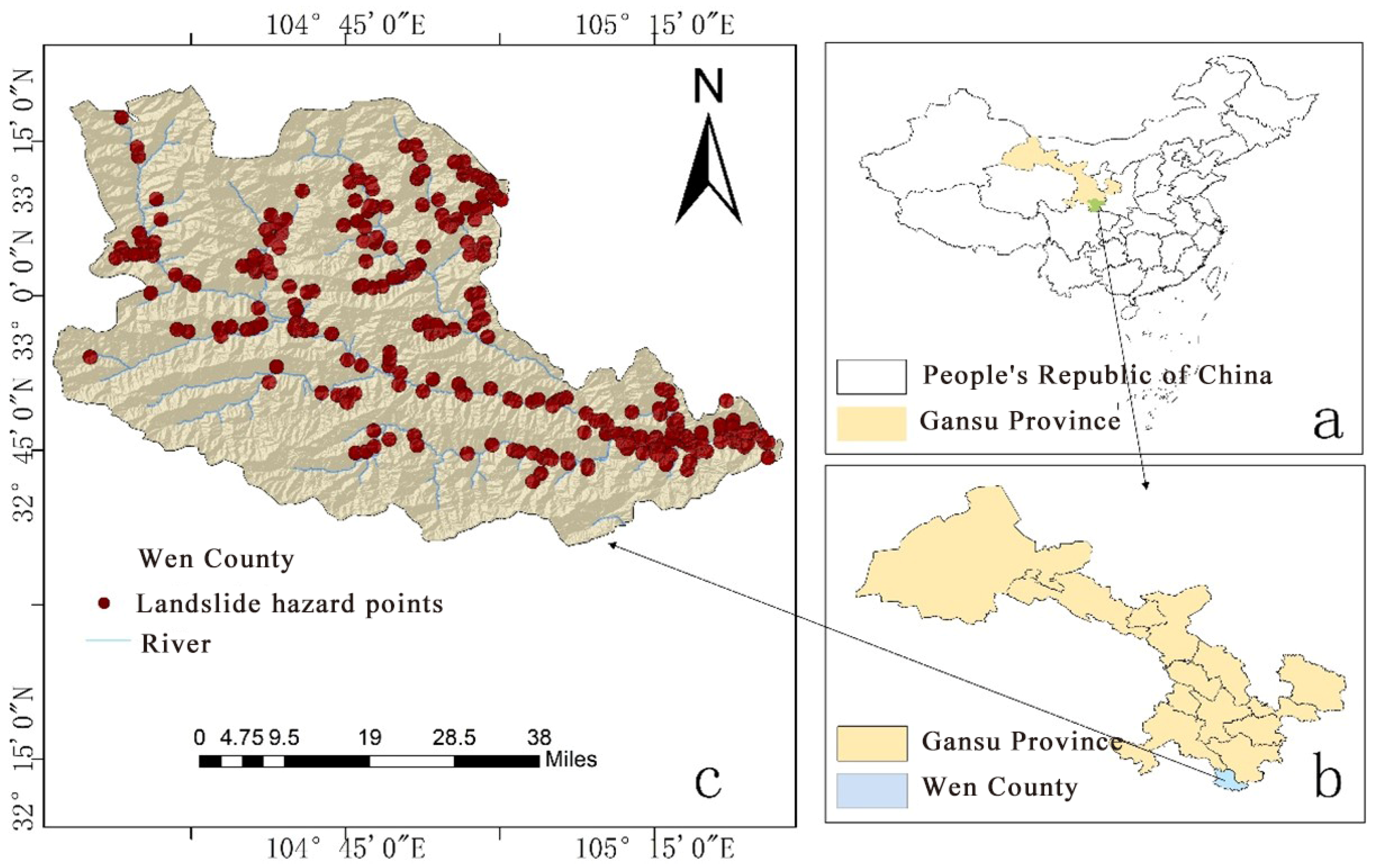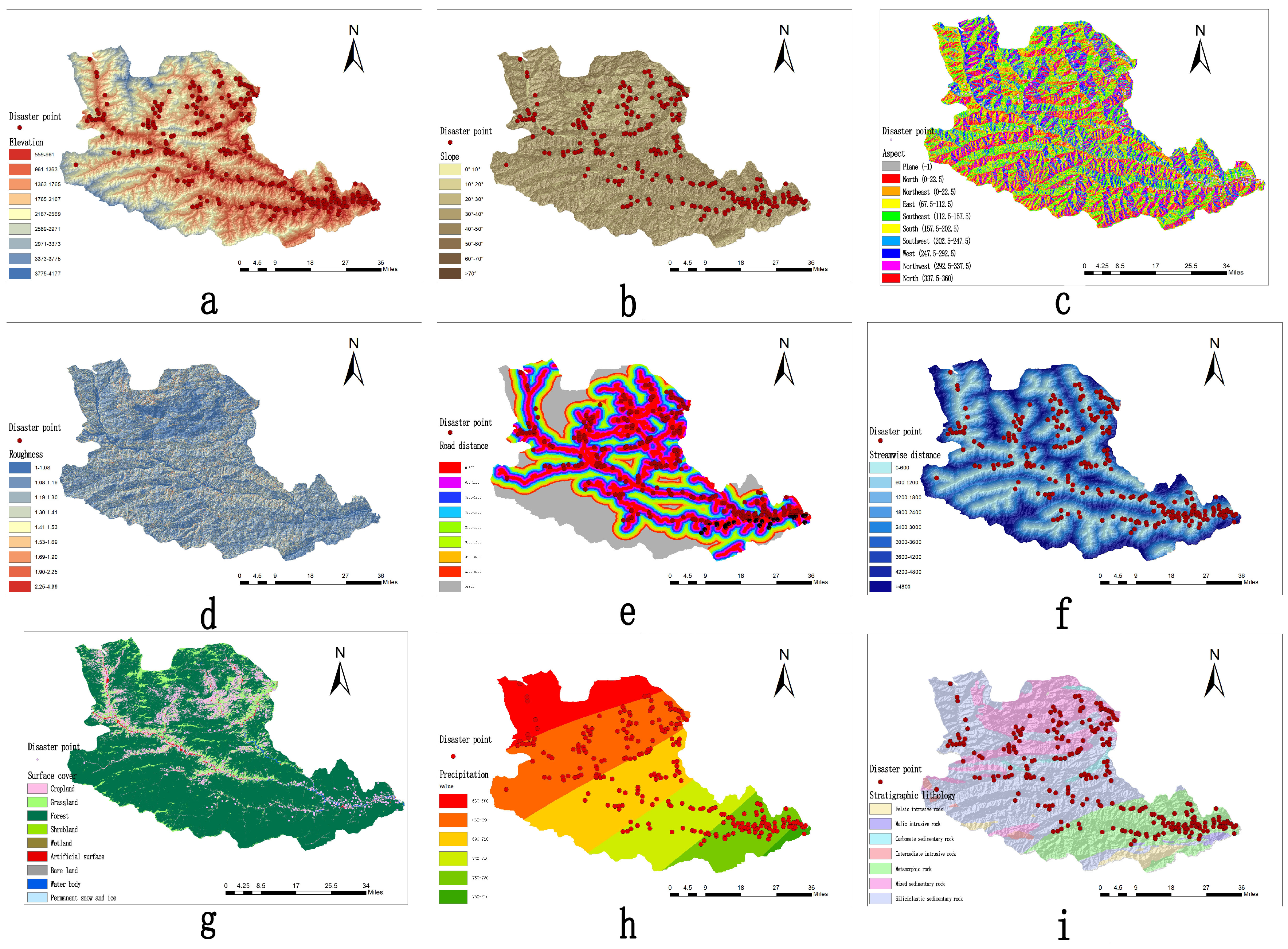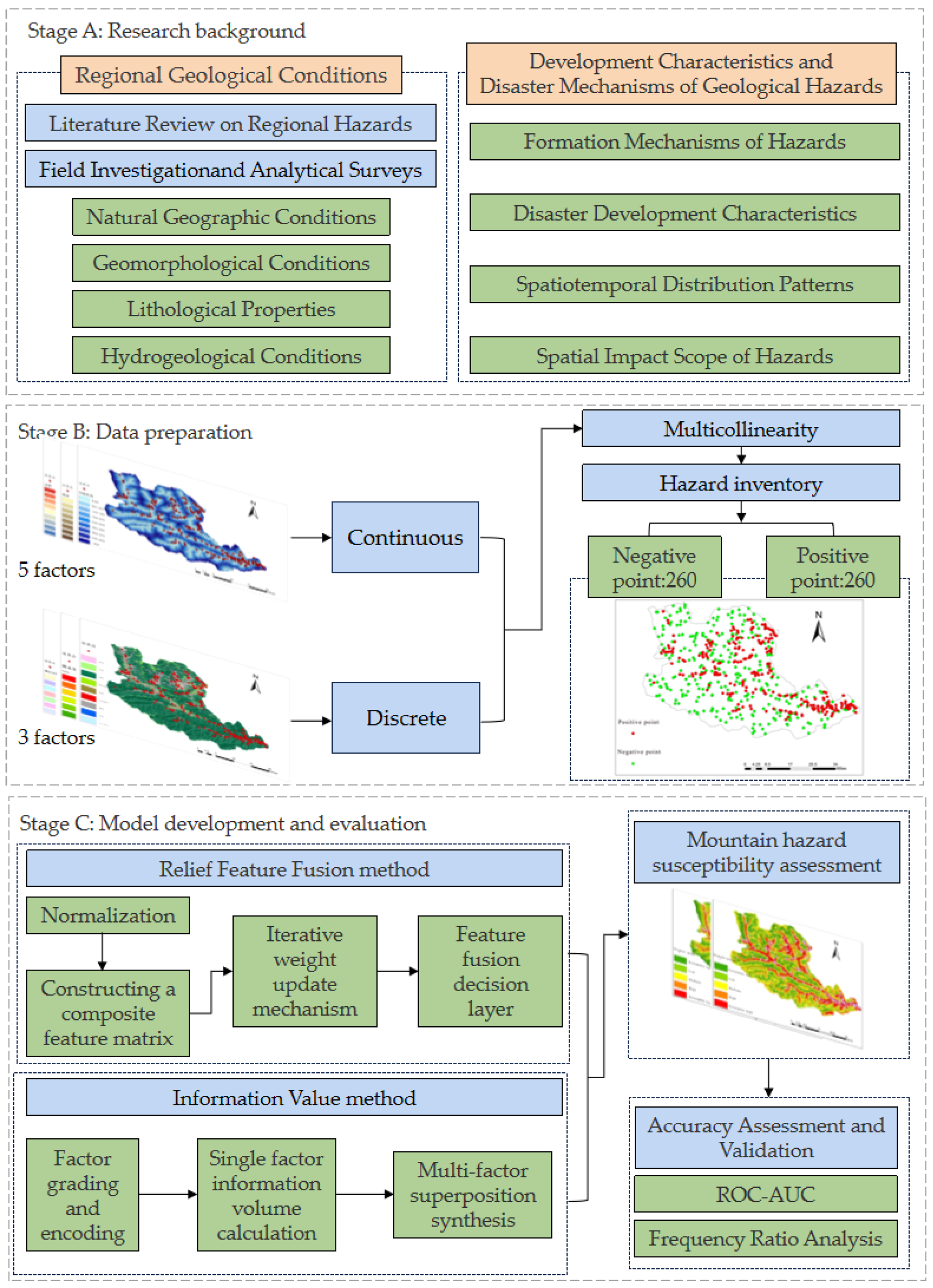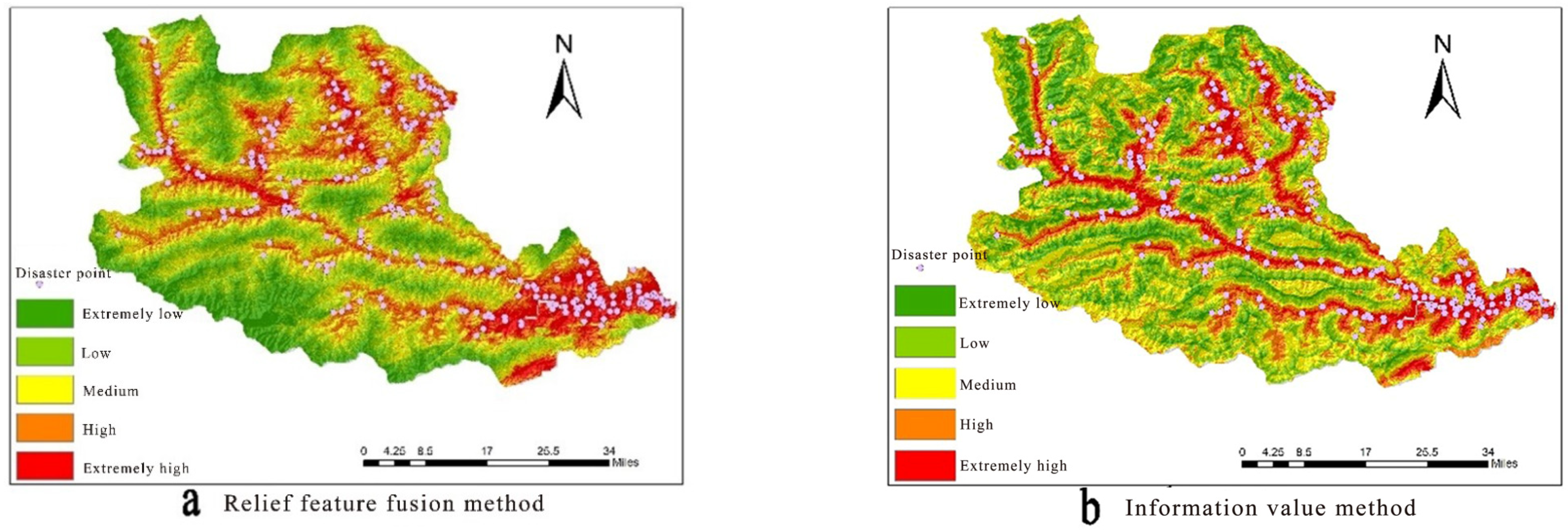Assessment of Landslide Susceptibility Based on ReliefF Feature Weight Fusion: A Case Study of Wenxian County, Longnan City
Abstract
1. Introduction
2. Study Area and Data Sources
2.1. Overview of the Study Area
2.2. Mountain Hazard Inventory
2.3. Data Preparation
2.4. Selection of Evaluation Factors
3. Research Methods
3.1. Data Processing
3.2. ReliefF Algorithm
- (1)
- Given a sample set K and a feature set F. Initialize the number of iterations m and the number of neighboring samples k.
- (2)
- Randomly select a sample from the sample set. Select nearest neighbors from the samples of the same class as , denoted as , and select nearest neighbors from the samples of different classes from , denoted as . Repeat the process until the number of iterations reaches .
- (3)
- Calculate the importance value .where A represents the feature; i represents the iteration number; represents the updated importance score of a specific predisposing factor after the i-th iteration. is the feature’s importance score from the previous iteration, serving as the baseline for iterative optimization. is the category assigned to the randomly selected training sample R. represents the distance between R and under A, determined by the difference between inter-class and intra-class distances, and a higher value indicates a stronger distinguishing ability of A for the samples [23].
- (4)
- Repeat step (3) N times (number of features) and output the importance vector W. The feature weight corresponding to A is
4. Results
4.1. Importance of Influencing Factors
4.2. Landslide Susceptibility Mapping
5. Discussion
6. Limitations and Future Perspectives
- (1)
- The spatiotemporal representativeness of hazard samples remains limited. Although this study utilized 260 historical landslide points with balanced positive/negative sampling through buffer zone randomization, the sample distribution was constrained by field survey resolution, potentially omitting concealed landslides or low-frequency events, which may compromise model generalizability.
- (2)
- Improved machine learning models based on the ReliefF algorithm will be attempted to capture more information in the feature space and handle more complex feature relationships and large-scale data while reducing the model scale, improving the overall performance and response speed of the classification model, and saving computational costs while improving prediction accuracy.
- (3)
- Future research should integrate dynamic factors such as seasonal precipitation variations and long-term climate trends into susceptibility modeling. This advancement will enable time-dependent risk assessments and improve early warning systems under climate change.
- (4)
- While our study incorporates “human activities” as a composite factor quantified through road density and land use types, localized activities such as quarries and mining were not explicitly modeled due to data resolution limitations. Future research should integrate high-resolution InSAR monitoring to capture subsidence effects from subsurface activities, along with field-measured drainage parameters, as these could refine susceptibility predictions in engineered slopes.
7. Conclusions
- (1)
- This paper selects eight evaluation factors, including stratum lithology, rainfall, elevation, aspect, slope, road distance, river distance, and land cover, to construct a landslide disaster risk assessment system. Using GIS technology, the eight evaluation indicators are quantified and graded. The extremely high and high-risk areas are mainly distributed along rivers and roads, with loose soil, high rainfall, low elevation, and dense vegetation, accounting for 66.51% of the total area. The dual driving forces of natural factors and human activities are the main factors inducing landslide disasters in Wenxian County.
- (2)
- This paper uses the ROC curve and frequency ratio to test the accuracy of the evaluation results and compares them with the evaluation results of the information value method. The AUC value of the ReliefF feature weight fusion method is 0.853, higher than the AUC value of 0.838 for the information value method, indicating good evaluation results. The extremely high susceptibility zone in the landslide susceptibility zoning map drawn by the ReliefF model (4.21) is larger than that drawn by the information value model (3.8), indicating higher prediction accuracy of the ReliefF method.
- (3)
- Computational cost is a crucial consideration in method selection. The cumbersome operation of the information value method limits its application in large-scale datasets, while machine learning methods have high computational costs and high computing power requirements, limiting their practical application in the industry. In contrast, the ReliefF feature fusion method has lower computational costs and better prediction accuracy, achieving a balance between accuracy and efficiency, making it more suitable for practical application scenarios that require processing large amounts of data.
Author Contributions
Funding
Institutional Review Board Statement
Informed Consent Statement
Data Availability Statement
Acknowledgments
Conflicts of Interest
References
- Wang, Y.; Tang, H.; Huang, J.; Wen, T.; Ma, J.; Zhang, J. A comparative study of different machine learning methods for reservoir landslide displacement prediction. Eng. Geol. 2022, 298, 106544. [Google Scholar] [CrossRef]
- Salciarini, D.; Fanelli, G.; Tamagnini, C. A probabilistic model for rainfall—Induced shallow landslide prediction at the regional scale. Landslides 2017, 14, 1731–1746. [Google Scholar] [CrossRef]
- Lan, H.X.; Zhou, C.H.; Wang, L.J.; Zhang, H.Y.; Li, R.H. Landslide hazard spatial analysis and prediction using GIS in the Xiaojiang watershed, Yunnan, China. Eng. Geol. 2004, 76, 109–128. [Google Scholar] [CrossRef]
- Zhou, H.; Mu, C.; Yang, B.; Huang, G.; Hong, J. Evaluating Landslide Hazard in Western Sichuan: Integrating Rainfall and Geospatial Factors Using a Coupled Information Value–Geographic Logistic Regression Model. Sustainability 2025, 17, 1485. [Google Scholar] [CrossRef]
- Huan, Y.; Song, L.; Khan, U.; Zhang, B. Stacking ensemble of machine learning methods for landslide susceptibility mapping in Zhangjiajie City, Hunan Province, China. Environ. Earth Sci. 2023, 82, 1–15. [Google Scholar] [CrossRef]
- Timmerman, P. Vulnerability, Resilience and the Collapse of Society. A Review of Models and Possible Climatic Applications. Environmental Monograph 1; Institute for Environmental Studies, University of Toronto: Toronto, ON, Canada, 1981. [Google Scholar]
- Bui, D.T.; Pradhan, B. Multi-scale convolutional neural networks (CNNs) for landslide susceptibility mapping using Sentinel-2 remote sensing imagery. Geomat. Nat. Hazards Risk 2024, 15, 1–20. [Google Scholar] [CrossRef]
- Du, G.-L.; Zhang, Y.-S.; Iqbal, J.; Yang, Z.-H.; Yao, X. Landslide susceptibility mapping using an integrated model of information value method and logistic regression in the Bailongjiang watershed, Gansu Province, China. J. Mt. Sci. 2017, 14, 249–268. [Google Scholar] [CrossRef]
- Xiaodong, W.; Yuan, L.; Jingbao, F. GIS-based assessment of geological disaster susceptibility in the water source area of the Bailongjiang Water Diversion Project. South North Water Transf. Water Sci. Technol. 2022, 20, 1231–1239. [Google Scholar]
- Yuan, Q.; Yong, L.; Yang, Z.; Zhen, X.U.; Miao, F.A. GIS-based hazard analysis of landslides and debris flows in Lanzhou. J. Glaciol. Geocryol. 2012, 34, 96–104. [Google Scholar]
- Xu, C.; Dai, F.; Yao, X.; Chen, J.; Tu, X.; Sun, Y.; Wang, Z. GIS-based landslide susceptibility assessment using AHP in Wenchuan earthquake area. Chin. J. Rock Mech. Eng. 2009, 28, 3978–3985. [Google Scholar]
- Wang, J.; Liang, F.; Peng, X.; Shi, W.; Yan, K.; Jiang, X. Research on the evaluation method of single collapse hazard range based on GIS technology. J. Eng. Geol. 2023, 31, 188–198. [Google Scholar]
- Mandal, S.P.; Chakrabarty, A.; Maity, P. Comparative evaluation of information value and frequency ratio in landslide susceptibility analysis along national highways of Sikkim Himalaya. Spat. Inf. Res. 2018, 26, 127–141. [Google Scholar] [CrossRef]
- Zhang, Q.K.; Ling, S.X.; Li, X.N.; Sun, C.W.; Xu, J.X.; Huang, T. Comparative study of rapid assessment models for landslide susceptibility in Jiuzhaigou County. Chin. J. Rock Mech. Eng. 2020, 39, 1595–1610. [Google Scholar]
- Chen, L.; Li, L.; Wu, F.; Xu, Y. GIS-based assessment of geological disaster susceptibility in Beiliu City using information value method. Earth Environ. 2020, 48, 471–479. [Google Scholar]
- Li, Y.; Yuan, J.; Jiang, D.; Wang, D.; Liu, X. GIS-based landslide risk assessment in the high mountain canyon area of southwest China—A case study of Lushui City, Nujiang Prefecture. J. Northwest Norm. Univ. (Nat. Sci. Ed.) 2021, 57, 94–102. [Google Scholar]
- Huang, F.M.; Yin, K.L.; Jiang, S.H.; Huang, J.; Cao, Z. Landslide susceptibility assessment based on cluster analysis and support vector machine. Chin. J. Rock Mech. Eng. 2018, 37, 156–167. [Google Scholar]
- Li, Z.; Du, J.; Xu, W. Vulnerability assessment of direct economic losses in rainfall-landslide disaster chains based on machine learning. J. Catastrophol. 2022, 37, 220–224. [Google Scholar]
- Goetz, J.N.; Brenning, A.; Petschko, H.; Leopold, P. Evaluating machine learning and statistical prediction techniques for landslide susceptibility modeling. Comput. Geosci. 2015, 81, 1–11. [Google Scholar] [CrossRef]
- Zhao, X.; Chen, W. Optimization of computational intelligence models for landslide susceptibility evaluation. Remote Sens. 2020, 12, 2180. [Google Scholar] [CrossRef]
- Reyes, O.; Morell, C.; Ventura, S. Scalable extensions of the ReliefF algorithm for weighting and selecting features on the multi-label learning context. Neurocomputing 2015, 161, 168–182. [Google Scholar] [CrossRef]
- Yang, C.; Shao, D.; Yang, Z. A multi-feature fusion model for Chinese short text classification. J. Chin. Comput. Syst. 2020, 41, 1421–1426. [Google Scholar]
- Wang, H.; Wang, P.; Deng, S.; Li, H. Improved Relief Weight Feature Selection Algorithm Based on Relief and Mutual Information. Information 2021, 12, 228. [Google Scholar] [CrossRef]
- Wang, Z.; Li, R.; Tuo, W. Study on the sudden start-up mode of debris flow based on historical observation data—A case study of the Bailong River Basin in the Longnan mountainous region. J. Catastrophol. 2019, 34, 140–144. [Google Scholar]
- Zhang, Y.; Li, X.; Chen, G. Landslide susceptibility assessment using DEMATEL-based analytic network process in Loess Plateau. Geomorphology 2021, 382, 107697. [Google Scholar] [CrossRef]
- Kumar, R.; Anbalagan, R.; Kumar, V. Objective landslide susceptibility assessment using CRITIC-weighted information value method in Himalayan terrain. Nat. Hazards 2022, 112, 541–570. [Google Scholar]
- Lee, S.; Park, I. Regional-scale landslide susceptibility mapping using SMART decision rules with limited inventory data: A case study from Central Asia. Environ. Earth Sci. 2023, 82, 215. [Google Scholar] [CrossRef]
- Wang, Z.; Chen, Z.; Ma, K.; Zhang, Z. Machine-Learning-Based Hybrid Modeling for Geological Hazard Susceptibility Assessment in Wudou District, Bailong River Basin, China. GeoHazards 2023, 4, 157–182. [Google Scholar] [CrossRef]
- Zhang, Z.; Liu, Z.; Qin, R.; Li, G.; Wen, G.; He, W. Real-time detection of laser shock peening protective layer burn-through based on ReliefF feature weight fusion. Spectrosc. Spectr. Anal. 2023, 43, 2437–2445. [Google Scholar]
- Wang, A.; Zhang, Y.; Liu, W.; Meng, X.; Li, Y.; Su, X. Development characteristics of landslides in the active fault zone of Wenxian County, northeastern margin of the Tibetan Plateau. J. Nat. Disasters 2023, 32, 239–250. [Google Scholar]
- Chen, W.; Li, Y. GIS-based evaluation of landslide susceptibility using hybrid computational intelligence models. Catena 2020, 195, 104777. [Google Scholar] [CrossRef]
- Cui, Y. Research on Landslide Susceptibility Assessment Methods Based on Different Evaluation Units: A Case Study of Luonan County, Shaanxi Province; Xi’an University of Science and Technology: Xi’an, China, 2021. [Google Scholar]
- Liu, Y.; Xu, S.; Liu, C.; Ma, Y. Landslide Susceptibility Assessment Considering Multi-Method Integrated Feature Selection and Negative Sample Optimization. Bull. Surv. Mapp. 2024, 74–79. [Google Scholar] [CrossRef]
- Mu, K.; Xie, W.; Liu, Q.; Yan, M.; Yang, H.; Li, J.; Huang, Y.; Zhu, R. Landslide susceptibility assessment based on LR-RF model—A case study of Yaozhou District, Tongchuan City. J. Catastrophol. 2022, 37, 212–218. [Google Scholar]
- Wang, S.; Huang, Y. Spatial spillover effects and driving factors of urban carbon emission intensity in China. Acta Geogr. Sin. 2019, 74, 1131–1148. [Google Scholar]
- Li, J.; Yang, H.; Bai, S.; Wang, J. Landslide sensitivity mapping and land use analysis in the Beiyu River Basin, Longnan mountainous region. In Innovative Theories and Methods of Risk Analysis and Crisis Response—Proceedings of the Fifth Annual Conference of the Risk Analysis Committee of the China Disaster Prevention Association; School of Geographical Sciences, Nanjing Normal University; Key Laboratory of Virtual Geographic Environment, Ministry of Education, Nanjing Normal University: Nanjing, China, 2012; p. 4. [Google Scholar]
- Liu, J. Research on the Group Occurrence Law and Mechanism of Large Landslides in the Longnan Mountainous Region; Lanzhou University: Lanzhou, China, 2020. [Google Scholar] [CrossRef]
- Achour, Y.; Boumezbeur, A.; Hadji, R.; Chouabbi, A.; Cavaleiro, V.; Bendaoud, E.A. Landslide susceptibility mapping using analytic hierarchy process and information value methods along a highway road section in Constantine, Algeria. Arab. J. Geosci. 2017, 10, 1–16. [Google Scholar] [CrossRef]
- Sun, R.; Wang, C.D.; Xia, Z.B.; Gao, W. Risk assessment of geological disasters in Fei County based on AHP-information value method. Environ. Sci. Technol. 2015, 38, 430–435. [Google Scholar]
- Xu, C. Automatic extraction and reliability test of earthquake landslide information based on maximum likelihood method. Chin. J. Geol. Hazard Control 2013, 24, 19–25. [Google Scholar] [CrossRef]
- Li, W.; Wang, X. Application and comparison of frequency ratio and information value models in landslide susceptibility assessment in loess gully region. J. Nat. Disasters 2020, 29, 213–220. [Google Scholar]
- Swets, J.A. Measuring the Accuracy of Diagnostic Systems. Science 1988, 240, 1285–1293. [Google Scholar] [CrossRef]
- Jiang, T.; Zhang, Q.; Hou, R.; Chai, L.; Mckee, S.A.; Jia, Z.; Sun, N. Understanding the behavior of in-memory computing workloads. In Proceedings of the Workload Characterization (IISWC), 2014 IEEE International Symposium on IEEE, Raleigh, NC, USA, 26–28 October 2014; pp. 22–30. [Google Scholar]
- Wang, J.; Zang, M.; Xu, C.; Liu, T.; Huang, Y. Landslide susceptibility assessment of the 2022 Luding earthquake based on AHP-ROC curve area coupling algorithm. J. Eng. Geol. 2024, 32, 1696–1711. [Google Scholar] [CrossRef]
- Xu, C. Panoramic review and comparative analysis of landslides triggered by the 2008 Wenchuan and 2013 Lushan earthquakes. Safety 2024, 45, 25–38. [Google Scholar] [CrossRef]








| Region | Landslide | Region | Landslide | Region | Landslide | Region | Landslide |
|---|---|---|---|---|---|---|---|
| Bikou Town | 16 | Zhongmiao Town | 41 | Tielou Tibetan Ethnic Township | 7 | Shifang Town | 1 |
| Sheshu Township | 13 | Jianshan Township | 10 | Baoziba Town | 17 | Linjiang Town | 14 |
| Liujiaping Township | 7 | Danbao Town | 7 | Fanba Town | 17 | Koutouba Township | 14 |
| Chengguan Town | 15 | Shangde Town | 11 | Shijiba Town | 15 | Tianchi Town | 6 |
| Yulei Township | 16 | Qiaotou Town | 13 | Liping Town | 9 | Zhongzhai Town | 4 |
| Data Name | Data Source |
|---|---|
| DEM | Geospatial Data Cloud (https://www.gscloud.cn/search) |
| Disaster Points | National Cryosphere Desert Data Center (http://www.ncdc.ac.cn/portal/) |
| Land Cover | Big Earth Data Science Engineering Data Sharing Service System (https://data.casearth.cn/) |
| Rainfall | National Oceanic and Atmospheric Administration (https://www.noaa.gov/) |
| Stratum Lithology | Geological Cloud (https://geocloud.cgs.gov.cn/) |
| Roads, Water Systems | National Geographic Information Resource Directory Service System (http://www.webmap.cn/) |
| Evaluation Factor | Classification | Disaster Points | Pixels in Region | Area Proportion |
|---|---|---|---|---|
| Elevation | 559–961 | 70 | 330,161 | 5.74% |
| 961–1363 | 74 | 869,044 | 15.12% | |
| 1363–1765 | 81 | 1,343,676 | 23.38% | |
| 1765–2167 | 33 | 1,418,293 | 24.67% | |
| 2167–2569 | 2 | 959,768 | 16.70% | |
| 2567–2971 | 0 | 514,603 | 8.95% | |
| 2971–3373 | 0 | 232,989 | 4.05% | |
| 3373–3775 | 0 | 74,172 | 1.29% | |
| 3775–4177 | 0 | 5452 | 0.09% | |
| Slope | 0–10° | 34 | 255,686 | 4.46% |
| 10–20° | 42 | 827,211 | 14.43% | |
| 20–30° | 72 | 1,622,552 | 28.30% | |
| 30–40° | 70 | 1,837,954 | 32.05% | |
| 40–50° | 32 | 968,526 | 16.89% | |
| 50–60° | 9 | 206,647 | 3.60% | |
| 60–70° | 1 | 15,438 | 0.27% | |
| >70° | 0 | 207 | 0.00% | |
| Aspect | Flat (−1) | 0 | 8726 | 0.15% |
| North (0–22.5) | 10 | 341,492 | 5.95% | |
| Northeast (22.5–67.5) | 31 | 749,020 | 13.06% | |
| East (67.5–112.5) | 41 | 725,794 | 12.66% | |
| Southeast (112.5–157.5) | 31 | 828,004 | 14.44% | |
| South (157.5–202.5) | 38 | 731,079 | 12.75% | |
| Southwest (202.5–247.5) | 47 | 671,861 | 11.72% | |
| West (247.5–292.5) | 27 | 617,196 | 10.76% | |
| Northwest (292.5–337.5) | 24 | 722,573 | 12.60% | |
| North (337.5–360) | 11 | 339,074 | 5.91% | |
| Roughness | 1–1.08 | 92 | 1,371,875 | 23.92% |
| 1.08–1.19 | 78 | 1,885,948 | 32.89% | |
| 1.19–1.30 | 43 | 1,240,875 | 21.64% | |
| 1.30–1.41 | 29 | 646,515 | 11.27% | |
| 1.41–1.53 | 8 | 326,013 | 5.69% | |
| 1.53–1.69 | 5 | 168,389 | 2.94% | |
| 1.69–1.91 | 4 | 68,820 | 1.20% | |
| 1.91–2.25 | 1 | 21,504 | 0.38% | |
| 2.25–4.99 | 0 | 4282 | 0.07% | |
| River Distance | 0–600 | 100 | 921,254 | 16.03% |
| 600–1200 | 71 | 828,528 | 14.41% | |
| 1200–1800 | 44 | 786,397 | 13.68% | |
| 1800–2400 | 19 | 740,984 | 12.89% | |
| 2400–3000 | 13 | 662,005 | 11.52% | |
| 3000–3600 | 8 | 591,411 | 10.29% | |
| 3600–4200 | 1 | 479,978 | 8.35% | |
| 4200–4800 | 2 | 337,160 | 5.87% | |
| >4800 | 2 | 400,480 | 6.97% | |
| Road Distance | 0–600 | 170 | 1,257,923 | 21.88% |
| 600–1200 | 64 | 813,914 | 14.16% | |
| 1200–1800 | 15 | 678,108 | 11.80% | |
| 1800–2400 | 6 | 572,441 | 9.96% | |
| 2400–3000 | 4 | 459,997 | 8.00% | |
| 3000–3600 | 1 | 346,495 | 6.03% | |
| 3600–4200 | 0 | 267,232 | 4.65% | |
| 4200–4800 | 0 | 218,364 | 3.80% | |
| >4800 | 0 | 1,133,723 | 19.72% | |
| Stratigraphic Lithology | Acidic Plutonic Rock | 4 | 157,682 | 2.77% |
| Basic Plutonic Rock | 1 | 47,539 | 0.83% | |
| Carbonate Sedimentary Rock | 11 | 102,336 | 1.80% | |
| Intermediate Plutonic Rock | 0 | 48,120 | 0.84% | |
| Metamorphic Rock | 89 | 1,263,623 | 22.19% | |
| Mixed Sedimentary Rock | 67 | 1,258,320 | 22.09% | |
| Siliceous Clastic Sedimentary Rock | 81 | 2,818,192 | 49.48% | |
| Surface Cover | Cultivated Land | 67 | 623,756 | 10.85% |
| Grassland | 44 | 521,242 | 9.07% | |
| Forest | 130 | 4,541,938 | 79.02% | |
| Shrubland | 0 | 18 | 0.00% | |
| Wetland | 0 | 651 | 0.01% | |
| Artificial Surface | 9 | 36,100 | 0.63% | |
| Bare Land | 0 | 1334 | 0.02% | |
| Water Body | 10 | 23,127 | 0.40% | |
| Permanent Snow and Ice | 0 | 16 | 0.00% | |
| Rainfall | 630–660 | 10 | 875,262 | 15.23% |
| 660–690 | 99 | 1,774,843 | 30.88% | |
| 690–720 | 46 | 1,340,941 | 23.33% | |
| 720–750 | 28 | 980,333 | 17.05% | |
| 750–780 | 68 | 706,969 | 12.30% | |
| 780–810 | 9 | 69,849 | 1.22% |
| Evaluation Factor | Stratigraphic Lithology | Precipitation | Elevation | Aspect | Slope | Road Distance | River Distance | Surface Cover |
|---|---|---|---|---|---|---|---|---|
| Contribution Value | 0.75 | 0.57 | 0.4 | 0.29 | 0.25 | 0.23 | 0.2 | 0.19 |
| Weight Value | 0.26 | 0.2 | 0.14 | 0.1 | 0.09 | 0.08 | 0.07 | 0.07 |
| Evaluation Model | Data Driven Model | Weight Assignment | Operation Process | Processing Time | Data Volume Size | AUC Value | Frequency Ratio | ||||
|---|---|---|---|---|---|---|---|---|---|---|---|
| Very Low | Low | Medium | High | Very High | |||||||
| ReliefF Method | Yes | Yes | Simple | Short | Medium | 0.853 | 0.00 | 0.05 | 0.39 | 1.62 | 4.21 |
| Information Quantity Method | Yes | No | Complex | Long | Large | 0.838 | 0.00 | 0.14 | 0.43 | 1.70 | 3.80 |
| Analytic Hierarchy Process | No | Yes | Simple | Short | Small | \ | \ | \ | \ | \ | \ |
Disclaimer/Publisher’s Note: The statements, opinions and data contained in all publications are solely those of the individual author(s) and contributor(s) and not of MDPI and/or the editor(s). MDPI and/or the editor(s) disclaim responsibility for any injury to people or property resulting from any ideas, methods, instructions or products referred to in the content. |
© 2025 by the authors. Licensee MDPI, Basel, Switzerland. This article is an open access article distributed under the terms and conditions of the Creative Commons Attribution (CC BY) license (https://creativecommons.org/licenses/by/4.0/).
Share and Cite
Wang, Z.; Zhao, C. Assessment of Landslide Susceptibility Based on ReliefF Feature Weight Fusion: A Case Study of Wenxian County, Longnan City. Sustainability 2025, 17, 3536. https://doi.org/10.3390/su17083536
Wang Z, Zhao C. Assessment of Landslide Susceptibility Based on ReliefF Feature Weight Fusion: A Case Study of Wenxian County, Longnan City. Sustainability. 2025; 17(8):3536. https://doi.org/10.3390/su17083536
Chicago/Turabian StyleWang, Zhijun, and Chenxi Zhao. 2025. "Assessment of Landslide Susceptibility Based on ReliefF Feature Weight Fusion: A Case Study of Wenxian County, Longnan City" Sustainability 17, no. 8: 3536. https://doi.org/10.3390/su17083536
APA StyleWang, Z., & Zhao, C. (2025). Assessment of Landslide Susceptibility Based on ReliefF Feature Weight Fusion: A Case Study of Wenxian County, Longnan City. Sustainability, 17(8), 3536. https://doi.org/10.3390/su17083536






